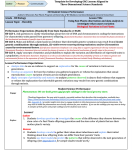Mendelian Inheritance Investigation with Fast Plants & CODAP
In this 26-page investigation—co-developed for secondary grades by teachers, the Wisconsin Fast Plants Program at UW-Madison, The Concord Consortium data scientists, and developers from Carolina Biological Supply, and Brett Moulding—learners investigate variation and inheritance in the “three dimensions” described by the Next Generation Science Standards. Included in the investigation materials are a lesson plan that includes an opening phenomenon, an inquiry similar to Mendel's pea experiment, data analysis prompts and guidance for using CODAP (free educational data analysis software) to analyze class data, and examples of sample student work. Data analysis for this investigation can be done with any preferred approach or software; however, for more from the Concord Consortium on using CODAP, you may find the blog post, Infusing Genetics With Data Science and Three-Dimensional Teaching helpful.
- NGSS.HS.LS3.2 Make and defend a claim based on evidence that inheritable genetic variations may result from: (1) new genetic combinations through meiosis, (2) viable errors occurring during replication, and/or (3) mutations caused by environmental factors. [Clarification Statement: Emphasis is on using data to support arguments for the way variation occurs.] [Assessment Boundary: Assessment does not include the phases of meiosis or the biochemical mechanism of specific steps in the process.]
- NGSS.HS.LS3.3 Apply concepts of statistics and probability to explain the variation and distribution of expressed traits in a population. [Clarification Statement: Emphasis is on the use of mathematics to describe the probability of traits as it relates to genetic and environmental factors in the expression of traits.] [Assessment Boundary: Assessment does not include Hardy-Weinberg calculations.]
- NGSS.MS.LS3.2 Develop and use a model to describe why asexual reproduction results in offspring with identical genetic information and sexual reproduction results in offspring with genetic variation. [Clarification Statement: Emphasis is on using models such as Punnett squares, diagrams, and simulations to describe the cause and effect relationship of gene transmission from parent(s) to offspring and resulting genetic variation.]

Comments